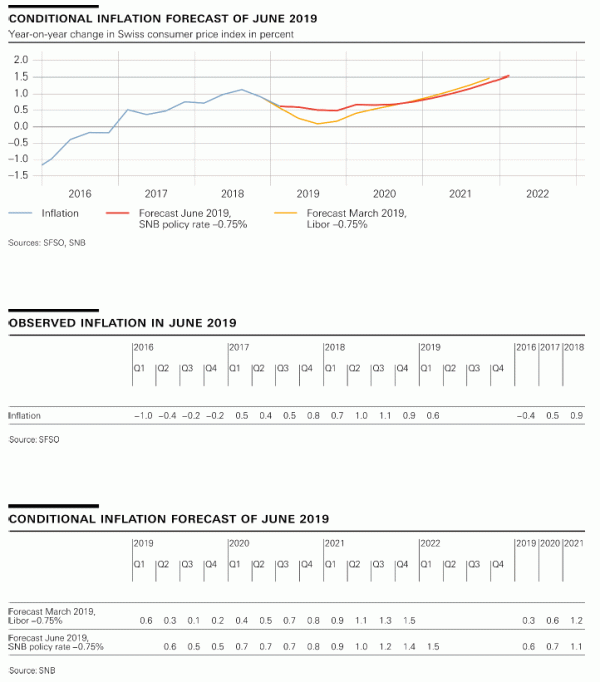The Swiss National Bank is maintaining its expansionary monetary policy, thereby stabilising price developments and supporting economic activity. Interest on sight deposits at the SNB is unchanged at –0.75%. The SNB will remain active in the foreign exchange market as necessary, while taking the overall currency situation into consideration.
The Swiss National Bank is today introducing the SNB policy rate.1 From now on, it will use this rate in taking and communicating its monetary policy decisions. The SNB policy rate replaces the target range for the three-month Libor used previously, and currently stands at −0.75%. The SNB’s monetary policy thus remains as expansionary as before. Interest on sight deposits held by banks at the SNB currently corresponds to the SNB policy rate and remains at −0.75%. The SNB will seek to keep the secured short-term Swiss franc money market rates close to the SNB policy rate. SARON is the most representative short-term money market rate today, and is also establishing itself as the reference rate for financial products.
The reason for introducing the SNB policy rate is that the future of the Libor is not guaranteed. The UK’s Financial Conduct Authority will only ensure that the Libor is maintained through to the end of 2021. The SNB’s conditional inflation forecast is based on the assumption that a given interest rate remains unchanged over the entire forecast horizon of three years. The three-month Libor has been used for this purpose to date. Given that the current forecast for the first time extends beyond the end of 2021, the introduction of the SNB policy rate ensures that it will be based on the same interest rate over the entire horizon.
The SNB’s expansionary monetary policy remains necessary against the backdrop of the current price and economic developments. On a trade-weighted basis, the Swiss franc is somewhat stronger than in March and is still highly valued. The situation on the foreign exchange market continues to be fragile. The negative interest rate and the SNB’s willingness to intervene in the foreign exchange market as necessary remain essential in order to keep the attractiveness of Swiss franc investments low and thus ease pressure on the currency.
The new conditional inflation forecast for the coming quarters is slightly higher than in March. This is primarily attributable to a rise in the prices of imported goods. The longer-term inflation forecast is virtually unchanged. For 2019 it stands at 0.6%, up from the figure of 0.3% last quarter. For 2020, the SNB anticipates an inflation rate of 0.7%, compared to 0.6% last quarter. The forecast for 2021 is 1.1%, 0.1 of a percentage point lower than last quarter. The conditional inflation forecast is based on the assumption that the SNB policy rate remains at –0.75% over the entire forecast horizon.
The signs from the global economy remain mixed. GDP growth picked up in the first quarter, with all large economies recording above-average expansion. However, manufacturing output again tended to weaken in a number of countries. In its baseline scenario for the global economy, the SNB expects growth in the coming quarters to remain in line with potential. In the advanced economies, expansionary monetary policy is lending support, as is fiscal policy in some countries. Inflationary pressure is likely to remain moderate. The risks to this baseline scenario are still to the downside. However, they are more pronounced than at our previous monetary policy assessment. Chief among them are political uncertainty and trade tensions, which could lead to renewed turbulence on the financial markets and a further dampening of economic sentiment.
The Swiss economy also gathered momentum at the beginning of the year. According to the initial estimate, GDP grew by 2.3% in the first quarter. Labour market developments were also positive. Production capacity in Switzerland was well utilised overall. The economic indicators point towards momentum remaining favourable. Against this backdrop, the SNB continues to expect the economy to grow by around 1.5% in 2019. As is the case with the global economy, the risks for this scenario remain to the downside. In particular, an unexpectedly sharp slowdown internationally would quickly spread to Switzerland.
Imbalances persist on the mortgage and real estate markets. Both mortgage lending and prices for single-family homes and privately owned apartments continued to rise slightly in recent quarters, while prices in the residential investment property segment declined somewhat. Nevertheless, due to the strong price increases in recent years and growing vacancy rates there is the risk of a correction in this segment in particular. The SNB will continue to monitor developments on the mortgage and real estate markets closely, and will regularly reassess the need for an adjustment of the countercyclical capital buffer.













